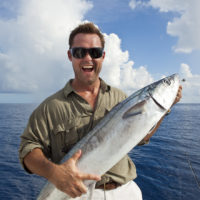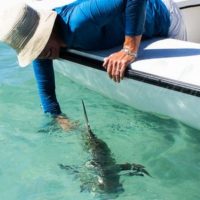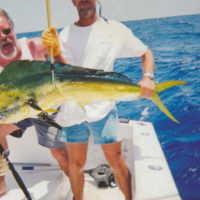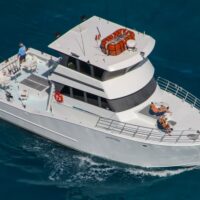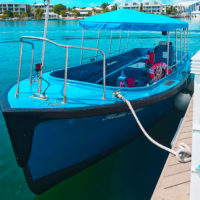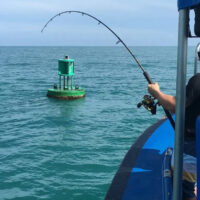Fishing for Wahoo in Key West
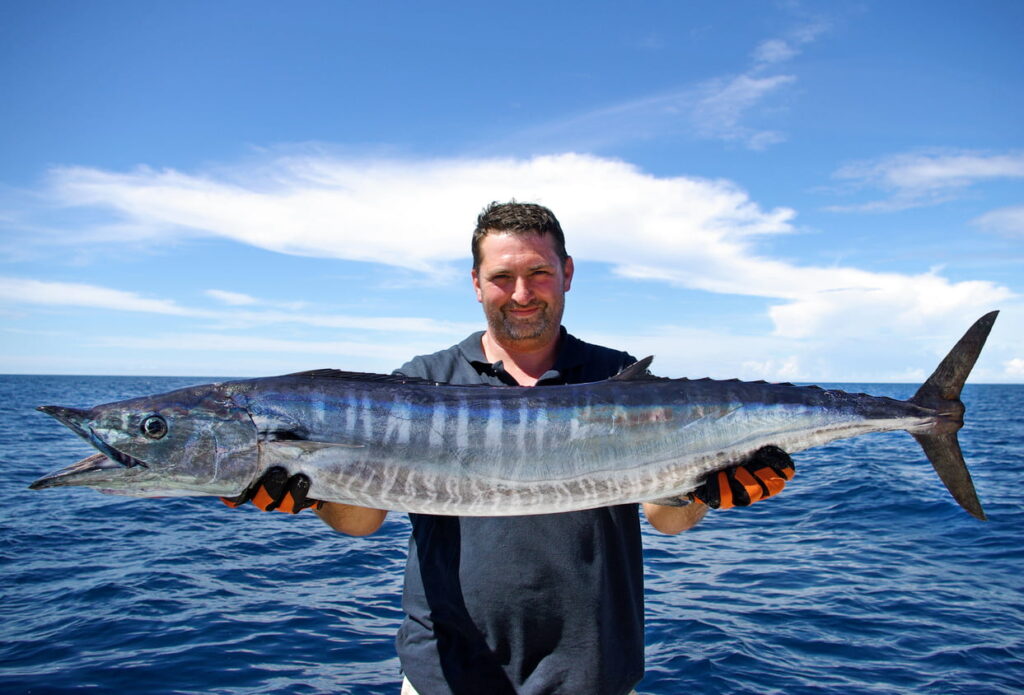
Wahoo are magnificent game fish famed as one of the fastest pelagic fish. They are elusive, relatively difficult to catch and delicious.
Wahoo (Acanthocybium solandri) information
(Florida Record 139lbs.) The Wahoo is one of the fastest fish in the sea, and it is highly prized by sport fishermen for its speed and high-quality flesh. Wahoo are slender, fast-looking fish much like Barracuda or Kingfish. The Wahoo’s body is covered with smooth, tiny scales. The head is pointed and the jaws are elongated into a beak-like snout and filled with razor-sharp teeth. The fish has two dorsal fins, with the first being several times longer than the second. Wahoo have dark blue or green coloration on their backs, and their lower sides and belly are silvery. They have 24 or more wavy cobalt blue vertical bars along their sides. Wahoo have been reported at a maximum length of 98 inches and a weight of 182 lbs., but a more typical size is 39 to 66 inches.
Wahoo Habitat and Behavior
Wahoo are found worldwide in tropical and subtropical waters. In the western Atlantic Ocean along the North American coast, they are found as far north as the Carolinas, but the abundance of Wahoo is highly seasonal, with peak numbers present in the warm summer months. Wahoo are widely distributed in the Gulf of Mexico and off the west coast of Central America. Wahoo are also present in the Mediterranean Sea and the Indian Ocean. In the central Pacific, Wahoo are well known by the Pacific islanders as food and sport fish. Wahoo are particularly prized in Hawai’i, where they are called Ono, or “good” in the native language.
Wahoo are pelagic fish, living in the open sea alone or in small, loose aggregations. Like many pelagic fish, they congregate near drifting objects including Sargassum weed, and venture out to forage in open water. Wahoo feed on other pelagic fishes such as Dolphinfish, Flyingfish, Porcupinefish, Little Tunny, Tuna, Squid and many other species. Wahoo can swim at speeds of up to 60 miles per hour in short bursts, and their endurance and speed allow them to pursue and quickly overcome prey.
Depending upon location and sex, Wahoo reach maturity between 1 and 2 years of age, and spawning appears to occur over an extended period of time in the Caribbean Sea and near Florida. Year-round spawning may take place in some areas. In the western central Atlantic, Wahoo spawn from May through August, with peaks during June and July. An average female may produce 60 million buoyant eggs per spawning. Wahoo are thought to live up to 5-6 years of age or more.
Fishing for Wahoo
Wahoo are magnificent game fish famed for their lightning strikes as they blast prey from below, and blazing speed as they strip line from the reel on the incredible first run. They are elusive, relatively difficult to catch, and their meat is among the best of all fish, further increasing their prize value to fishermen. They are not often found in large groups in Key West waters, but have been reported gathered in large schools and hanging motionless over the wrecks out in the Gulf.
Traditionally, Wahoo have been fished with high-speed trolling methods, making heavy tackle a necessity. Some Key West light tackle boats have been developing slow trolling techniques where multiple live baits are presented at different depths while the boat drifts along a ledge or over a wreck with the engine off. Fishing at daybreak or sunset can increase the chances of catching Wahoo, and tide changes around the full moon are also favorable for Wahoo fishing. Specific techniques to target this magnificent fish are still under development, and the challenge of finding and catching Wahoo on light tackle is every bit as sporting as going after Marlin on heavy gear.

